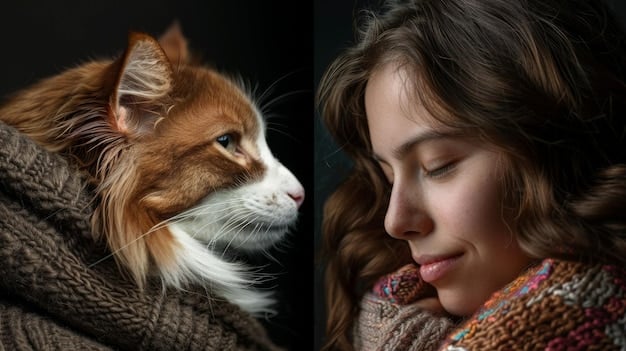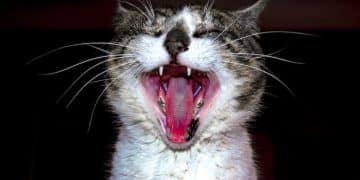Rare Cat Breeds: Exploring Availability in the US Market in 2025

Rare cat breeds, characterized by unique traits and limited populations, may see fluctuating availability in the US market by 2025, influenced by breeder activity, genetic diversity, and rising consumer interest.
The allure of unique and exotic pets continues to captivate enthusiasts, and the world of felines is no exception. As we approach 2025, the demand for distinct and less common cat breeds is expected to grow in the US market. This article delves into the fascinating realm of rare cat breeds, examining their profiles and anticipated availability, offering a glimpse into the future landscape of feline companionship.
Understanding the Concept of “Rare” in Cat Breeds
Defining “rare” in the context of cat breeds isn’t always straightforward. Factors such as the number of registered cats, the geographical distribution, and the presence of specific genetic traits all contribute to a breed’s rarity. It’s not merely about low numbers; it’s also about the risk of genetic bottlenecks and the effort required to maintain a healthy population.
Factors Contributing to Breed Rarity
Several factors influence the rarity of a cat breed. Understanding these elements is crucial for appreciating the challenges faced by breeders and enthusiasts working to preserve these unique feline lineages.
- Limited Gene Pool: Small populations often lead to inbreeding, reducing genetic diversity and increasing the risk of inherited health problems.
- Geographic Isolation: Breeds originating from specific regions may have limited exposure to other populations, hindering their spread and recognition.
- Breeding Challenges: Some rare breeds may have specific breeding requirements or health issues that make them difficult to propagate.

The rarity of a cat breed can also depend on its recognition by major cat registries like The Cat Fanciers’ Association (CFA) and the International Cat Association (TICA). Official recognition often leads to increased awareness and, potentially, greater availability.
Khao Manee: The Diamond Eye Cat
The Khao Manee, also known as the “Diamond Eye” cat, is a striking breed originating from Thailand. Its most distinguishing feature is its mesmerizingly clear blue or odd-eyes (one blue and one of another color). Historically cherished by Thai royalty, this breed remains relatively rare outside of its native land.
Characteristics and Personality
Beyond their captivating eyes, Khao Manees possess a sleek white coat and a muscular build. They are known for their playful and affectionate nature, making them wonderful companions.
- Appearance: Pure white coat, often with striking blue or odd-colored eyes.
- Temperament: Intelligent, curious, and highly social.
- Health: Generally healthy, although deafness can occur in blue-eyed white cats.
In the US market in 2025, the Khao Manee is likely to remain a rare find. High demand and limited breeding programs contribute to its scarcity. However, with increased awareness and responsible breeding practices, its availability may gradually improve.
Kurilian Bobtail: The Pom-Pom Tail Feline
The Kurilian Bobtail is a distinctive breed originating from the Kuril Islands, a volcanic archipelago between Russia and Japan. Its defining characteristic is its short, fluffy, pom-pom-like tail, which results from a natural genetic mutation.
Unique Traits and Temperament
Kurilian Bobtails are known for their robust health and adaptability. Their semi-cobby body and thick fur make them well-suited to colder climates. They are often described as dog-like in their loyalty and playful demeanor.
- Tail: Short, flexible, and uniquely shaped, varying from a “pom-pom” to a more curved appearance.
- Personality: Intelligent, affectionate, and good with children and other pets.
- Care: Requires regular grooming, especially during shedding season.
The Kurilian Bobtail’s availability in the US market in 2025 will likely remain limited by breeder numbers and distances. This breed is slowly gaining recognition, however, an increased popularity could lead to more opportunities to purchase one.
LaPerm: The Curly-Coated Charmer
The LaPerm is a relatively new breed that originated in the United States in the 1980s. Its hallmark is its curly or wavy coat, which comes in a variety of colors and patterns. This unique and endearing physical feature has won the LaPerm many fans.
Coat Variations and Personality
LaPerms have a distinctive coat that can range from tight ringlets to loose waves. They are known for being hypoallergenic, which makes them a sought-after choice for allergy sufferers. They are celebrated for their gentle and interactive temperament.
- Coat: Curly or wavy, soft to the touch and relatively low-shedding.
- Grooming: Regular brushing is needed to prevent mats and tangles.
- Health: Generally healthy and robust.

The LaPerm is gaining popularity in the US market. Despite this increased visibility, their availability may still be moderate because not all breeders may specialize in this more unusual cat.
Minskin: The Low-Riding Feline
The Minskin is a relatively new and rare breed known for its short legs and sparse fur. It was created by crossing a Munchkin with a Sphynx in Boston, Massachusetts. It is celebrated and desired for its unique physical characteristics.
Appearance and Temperament
Minskins are recognized for their short stature, wrinkled skin, and large ears. Despite their physical attributes, Minskins are active and playful. They can come in a range of colors and patterns.
- Appearance: Short legs, sparse coat, and wrinkled skin.
- Care: Requires regular grooming to maintain the health of their skin.
- Health: Prone to similar health issues as Munchkins and Sphynx cats.
In the US market, the Minskin’s future will be determined by breeder efforts and consumer interest. The limited supply and specific care needs may restrict widespread availability.
American Wirehair: The Wirey Wonder
The American Wirehair is a breed of domestic cat originating in upstate New York. The Wirehair is known for its coarse, crimped fur that gives it an unkempt appearance. It’s not particularly common, but continues to win fans who like this distinct coat.
Coat and Personality
The American Wirehair sports a resilient, springy coat, with each hair crimped or bent. As a rule, this breed is playful, affectionate, and easily adaptable. They are sociable, and good with other pets.
- Appearance: Crimped, springy coat that stands out.
- Care: Very little grooming is needed, since the coat does not mat easily.
- Health: No particular breed related health issues.
Availability of the Wirefhair in the US market is expected to grow. These hardy felines continue to gain devotees, which provides breeders with new incentives.
| Key Feature | Brief Description |
|---|---|
| 💎 Khao Manee | Striking “diamond” eyes, pure white coat, rare outside Thailand. |
| 🧶 LaPerm | Curly coat, hypoallergenic potential, gaining popularity in the US. |
| 🐾 Minskin | Short legs, sparse fur, health needs will impact their relative scarcity. |
| 🇷🇺 Kurilian Bobtail | Pom-pom tail, robust health, availability rising in the US market. |
Frequently Asked Questions
▼
A cat breed is generally considered rare if it has a small registered population, limited genetic diversity, or is geographically isolated. Recognition by major cat registries also plays a role. Genetic health and specific physical characteristics make some breeds particularly rare.
▼
Start by researching breed-specific clubs and registries. Ask for health records, visit the breeder’s facilities, and ensure they prioritize the health and well-being of their cats. Check online reviews and ask for references to assess reputation.
▼
Yes, rare cat breeds often come with a higher price tag due to the limited availability and the specialized breeding efforts required to maintain healthy populations. Demand and rarity both play factors in determining the final cost.
▼
Due to smaller gene pools, some rare breeds may be prone to specific genetic health issues. It’s important to research the breed’s common health problems and choose a breeder who performs health screenings on their cats.
▼
Support responsible breeders who prioritize genetic diversity and health. Educate others about the importance of preserving these unique feline lineages. Consider donating to breed-specific conservation efforts or participating in cat shows.
Conclusion
As we look ahead to 2025, the landscape of rare cat breeds in the US market promises to be both intriguing and dynamic. While availability may fluctuate for breeds like the Khao Manee, Kurilian Bobtail, LaPerm, Minskin and American Wirehair, their unique characteristics and devoted enthusiasts ensure their continued presence. By understanding the factors that contribute to a breed’s rarity and supporting responsible breeding practices, we can help preserve these extraordinary felines for generations to come.





